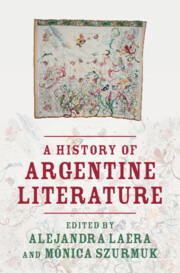Book contents
- A History of Argentine Literature
- A History of Argentine Literature
- Copyright page
- Contents
- Figures
- Contributors
- Editors’ Acknowledgments
- Introduction
- Part I Literary Dates
- Part II Critical Inroads
- Part III Literary Names
- Chapter 21 Sarmiento: Politics, Culture, and Spectacle
- Chapter 22 The Mansilla Siblings: A Story in Syntony
- Chapter 23 Martín Fierro: Subaltern Voices
- Chapter 24 Borges and Argentine Literature: A Detour around the World
- Chapter 25 Roberto Arlt
- Chapter 26 The Ocampo Sisters
- Chapter 27 Alfonsina Storni and Alejandra Pizarnik
- Chapter 28 Displacement and Transfer in Julio Cortázar’s Todos los fuegos el fuego
- Chapter 29 Manuel Puig’s Circuit Bending: Literary Listening against Surveillance
- Chapter 30 Operation Massacre: Dangerous Journalism
- Chapter 31 The Politics of the Poem: From Gelman to Perlongher
- Chapter 32 Scenes from Postmodern Life: Literary Interventions in the Public Sphere
- Chapter 33 Griselda Gambaro and Beyond: A “Dermography” of Contemporary Women’s Theater and Performance
- Chapter 34 César Aira and the Art of Invention
- Index
- References
Chapter 31 - The Politics of the Poem: From Gelman to Perlongher
from Part III - Literary Names
Published online by Cambridge University Press: 09 May 2024
- A History of Argentine Literature
- A History of Argentine Literature
- Copyright page
- Contents
- Figures
- Contributors
- Editors’ Acknowledgments
- Introduction
- Part I Literary Dates
- Part II Critical Inroads
- Part III Literary Names
- Chapter 21 Sarmiento: Politics, Culture, and Spectacle
- Chapter 22 The Mansilla Siblings: A Story in Syntony
- Chapter 23 Martín Fierro: Subaltern Voices
- Chapter 24 Borges and Argentine Literature: A Detour around the World
- Chapter 25 Roberto Arlt
- Chapter 26 The Ocampo Sisters
- Chapter 27 Alfonsina Storni and Alejandra Pizarnik
- Chapter 28 Displacement and Transfer in Julio Cortázar’s Todos los fuegos el fuego
- Chapter 29 Manuel Puig’s Circuit Bending: Literary Listening against Surveillance
- Chapter 30 Operation Massacre: Dangerous Journalism
- Chapter 31 The Politics of the Poem: From Gelman to Perlongher
- Chapter 32 Scenes from Postmodern Life: Literary Interventions in the Public Sphere
- Chapter 33 Griselda Gambaro and Beyond: A “Dermography” of Contemporary Women’s Theater and Performance
- Chapter 34 César Aira and the Art of Invention
- Index
- References
Summary
After three decades of vanguards there was a colloquial turn in Latin American poetry. Nicanor Parra’s Poemas y antipoemas, César Fernández Moreno’s Argentino hasta la muerte, Carlos Martínez Riva’s La insurrección solitaria and Neruda’s Odas elementales – all published in 1954 – show the abandonment of the oneiric in favor of a less fancy language and new links with popular culture. Juan Gelman’s Gotán (1962) is included in this trend. A decade later, exile marks an unexpected turn: Gelman will not only speak of defeat and death but will also impel exile and death on his lines: it is about not only the political in the poem but the politics of the poem. Therein resurfaces a key American issue: the need to construct a tradition. Gelman’s Hechos y relaciones (1980) and Citas y comentarios (1982) are contemporary with the first publications by Néstor Perlongher (Austria-Hungría, 1980; Alambres, 1987). With his Neobarroso, Perlongher proposes a relationship with the popular born of the curtailment in a domestic lexicon, an extolment of the kitsch and pop. Unlike Gelman, who finds in Europe the breadth of poetry, Perlongher discovers in Brazil the reciprocation of two systems, of Hispanic America and the Portuguese-speaking world.
- Type
- Chapter
- Information
- A History of Argentine Literature , pp. 489 - 506Publisher: Cambridge University PressPrint publication year: 2024

